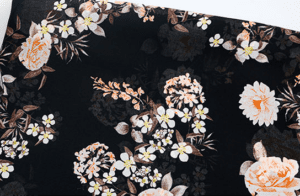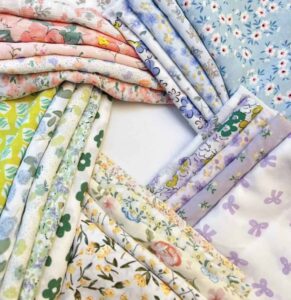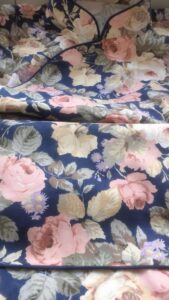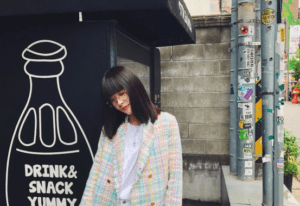Digital printing is a new type of printing developed in the late 1990s, using an integrated CAD processing system from input processing to printing. The process consists of transferring the image to a computer via a camera or scanner, using image processing software to sort the colours, and then spraying each single colour directly onto the fabric via a computer-connected nozzle, drying it and then processing it afterwards to complete the printing process. The biggest advantage of digital printing is that there is no restriction on the number of sets of printed flowers, no restriction on the return position and no restriction on the colour; the bionic nature is very strong and the photographic effect is realistic: the printing process is free from environmental pollution and is also very suitable for small quantities and personalised design printing; digital printing is a plateless and cylinder-free printing, which has completely changed the traditional method of transferring printing pastes; the digital synthesis effect greatly shortens the proofing cycle and reduces The digital synthesis effect greatly shortens the proofing cycle, reduces the cost of proof production and solves the dilemma of high energy consumption, high emissions, high pollution and low added value of the current traditional process in the textile industry.
Basic structure and characteristics of digital printing machine
At present, the commonly used digital printing machine is a belt-guided digital printing machine. The belt-guided digital jet printing machine consists of a computer and a printing machine. The printer consists of an ink supply system, a cleaning device, a moisturising device, a cloth feeding device, a guide belt transfer, a washing device and a drying and reeling device. The computer can be configured according to the customer’s needs and is used as a control centre to process the flower shapes and direct the entire printing process. The computer is made up of two parts: the host computer and the external equipment. The host computer consists of the main system board (CPU), power supply, display device, print device and other major plug-ins as well as the hard disk, CD-ROMN sound bar card, etc. The host computer is controlled using the RIP software VEGAprint to control the printing. External devices include input devices and output devices, including keyboards, mice, scanners, etc.; output devices include monitors, printers, plotters. For digital printers, in addition to the configuration of the mainframe and external devices, an uninterruptible power supply (UPS) is also required to ensure that the computer is provided with a high quality power supply that is voltage, frequency, uninterruptible and anti-jamming in the event of a power failure or voltage instability. The printers contain multiple print heads that spray the colour directly onto the fabric. The fabric feed device includes guide spokes, tight fabric spokes and pressure dropouts, the tight fabric spokes are used to adjust the fabric to the fabric tension, the pressure spokes are the fabric firmly and flatly attached to the guide belt. The sprayed fabric is immediately dried through the drying room and then rolled. The whole process of jet printing is completed.
There is another type of digital printing machine called digital electrostatic printing machine, which is studied in both the USA and Japan, but the principle is different. Controlled LEDs follow the input pattern information to irradiate the lighted part of the screen so that the positive surface charge is lost, while the unirradiated part of the screen remains positively charged electrostatically latent. When the cylinder is rotated, the positively charged latent image on the surface comes into contact with the negatively charged developer, which forms the image under electrostatic force, and the image is then transferred to the fabric. If the pattern is changed, the original screen can be cleaned and used again. The four-colour (CMYK) dyestuff can be used to print at speeds of up to 5 ~ This equipment is expected to be used as an alternative to traditional printing machines in recent years. Tables 1-1 and 1-2 show the main features of the different models of inkjet printing equipment for reference.
Table 1-1 Main characteristics of a typical DBP type digital printing machine:
Table 1-2 Vega inkjet printing machine models and maximum print speeds
The image processing of digital printing
There are many different versions of image processing software for inkjet printing, especially specialised software for pattern processing, including Honghua and Jinchang, as well as the general-purpose Photoshop series, and some foreign pattern processing software. There are slight differences in processing methods, but the aim is the same. Here is a description of Hong Hua’s AT2000 printing and dyeing colour separation design software V2000.
ATSL is a vector version of the computer print colour separation software and is the standard program for editing, colour separation, design and post-processing of various print patterns. It includes vector processing, scanning input, format processing, image adjustment, line drawing, silk skimming, clay dot enrichment, airbrush painting: continuous sunlight display, cloud pattern generation, noise removal, colour separation, screen preview, pattern design, image opening and cloud hanging, etc. to complete the colour separation process.
The original print is first scanned in, then the pattern is trimmed, opened and returned to position, and then divided into colours, after which the necessary processing is carried out for each individual colour. There are no special requirements for digital printing, unlike flat screen printing, which requires a limit of 3cm. For digital printing, the open circuit is as long as it follows the normal return of the pattern, but only for the convenience of processing the image itself.
The pattern contains several sets of colours, which can be divided into several sets of monochrome by the software, because digital printing is not limited by sets of colours. Each set of single-colour processing includes the integrity of the side channels, the repair of the missing parts, the treatment of mud spots, the treatment of cloud patterns, the treatment of expanding or closing lines, the treatment of the parts of the compound colour, the treatment between the contrasting colours, and the addition of dots and other processes, in line with the needs of digital printing, in order to make the printed flower shape as much as possible to maintain the spirit of the original pattern. Of course, if inkjet printing is used for proofs produced by large machines, then the processing needs to take into account the traditional print forms, such as overlay, re-colouring and fineness.
After the colour separation process, the pattern is matched again, i.e. according to the special colour matching software of the inkjet E press. The colours can be matched directly on the computer screen or with a colour matching card. Colour matching on the screen, all the colour light is not possible to achieve a complete re-enactment through the dye, this method is only suitable for designers to use when swapping colours to design a colour match, simple, fast and clear, but does not require a high degree of accuracy in colour matching. Another colour matching method is the colour card, inkjet printers usually have colour matching cards made in CMYK mode, RGB mode and LAB mode. The original colour is compared to the colour card colour, and the closest colour mark is chosen to be printed on the fabric for comparison, then adjusted and printed again, which can also be called a single colour strike off..This method is undoubtedly the most accurate and quickest method for clear colour blocks, but as printing is different from dyeing, the colours in the pattern are often mixed and overlapped, for example, clouds, clay dots, shades of overtones, etc. cannot be accurately read out with a computerised colourimeter. This is why there are limitations in its application. It is also possible to use traditional manual colour matching, which requires a professional colourist to carry out the work.
The various processes of dye print handling, colour separation, resizing and blank preparation must all take into account the future processing implications. The shrinkage of the blank after the immersion of the auxiliaries must be known, then the elongation of the patch must be taken into account, combined with the shrinkage requirements of the finished product, and then the ratio of warp to weft shrinkage or enlargement of the pattern must be decided, which is the key to achieving pattern size reproducibility in digital printing. If digital printing is for large machine printing proofs, then as a confirmation of the sample to the customer also take into account the large machine production when the effect of the compound colour (third colour), so that the small sample printed on the large machine production to be able to repeat, this is because the large machine production is far less accurate than digital printing.
Paste selection for digital printing
Digital printing was first used in paint printing, because paint printing is suitable for almost all fabrics and does not require post-processing after printing, the process is simple. Later, with the development of inkjet printing inks, disperse dyes, acid dyes and reactive dyes were developed successfully, making the inkjet printing process richer and more practical. For dye printing fabric sizing, the paste plays two roles, one is to make the ink containing the dye sprayed onto the fabric is fixed in the paste and will not spread outwards, maintaining the clarity and smoothness of the outline of the flower shape, the second is that the fabric in the steaming above the dye and fibre combination must be carried out under certain pH conditions and certain conditions of the presence of additives, so the quality of the dye inkjet printing colour and The choice of paste is related. For example, inkjet printing of reactive dyestuffs has relatively high requirements for fabrics, which must be sized before printing, i.e. the fabric must be pre-rolled with a certain amount of alkali and urea that can make the reactive dyestuffs colourful; for disperse and acid dyestuff printing, the same auxiliaries must be rolled on the fabric. For the printing of disperse dyes, the fabric must be sized by adding a certain amount of Hyun Sulphate to the sodium fucoidan paste, while for the printing of acid dyes, the fabric can be sized by adding urea, Hyun Tartrate or Hyun Sulphate.
The paste used in digital printing is a type of fucoidan, which is the result of the polymerisation of B-l, 4-DM mannuronic acid and 8-1, 4-LG gulonic acid, with a molecular weight between 25,000 and 32,000. The -COOH in the fucoidan molecule is present in water in the form of a COO -, which makes the repulsive force between the hydroxyl groups greater than the force of the intermolecular hydroxide bonds, so that it does not form a net-like structure, but is dispersed in water in the form of a true molecule. When metal ions are present in the solution, the -coo- is combined with it and its rheological properties are reduced. This is the reason why soft water is required when making pastes or pastes. Fucoidan is widely used because of its good homogenising, permeability and easy washing properties. The basic molecular structure of fucoidaner is as follows.
Fabric preparation for digital printing
Digital printing on the blank fabric requirements burnt hair to clean, desizing rate to be high, cooking to be transparent, bleaching degree is good, preferably by the mercerization treatment. The quality of cooking is often used to measure the quality of capillary effect (referred to as the gross effect), the test will be about 2Ycm end of the fabric vertically immersed in water, measuring the height of the water in the fabric after 30 minutes, that is, the gross effect. General requirements to 8-10cm/30min and above. You can also use the drip test to test the gross effect, with a drop of water on the fabric, the water droplets quickly permeate that good permeation, water droplets do not permeate but roll like water droplets that infiltration is very poor, infiltration of the fabric digital printing after the low amount of colour.
The purpose of sizing the pre-treated fabric is to prevent bleeding of the dye from being spray-printed onto the surface of the cotton needlework, thus obtaining a clear pattern. It promotes the combination of dyestuff and fibre in a hot and humid state to obtain a certain colour depth and colour fastness. The sizing methods are round sizing, flat or dipping (double sided), single sided (sizing), spraying, etc.
The sizing process is as follows.
Blending of slurry f dipping or sizing on one side (roll margin around 75-85%)…drying (drying temperature below 90°C)
-rolled cloth.
Sizing requirements are even Uniformity, no wrinkling of the fabric, no rolled edges, stable width, good control of weft slope, weft slope less than 3%. Keep the moisture content of the fabric consistent when drying. The fabric with good sizing is best stored in a sealed plastic bag to avoid moisture absorption in the air, which will affect the quality of the printing.
For example, reactive dyes need to be alkaline and hot and humid in order to develop colour, so the blank must be pre-impregnated with a solution of urushiol to allow the reactive dyes to evaporate through the vapour on the blank. Acid dyestuffs are mainly used for printing on silk and nylon fabrics, where the printed fabric also needs to be treated by impregnating it with a colouring agent. Disperse dyestuffs have to be vapour-evaporated or baked at a high temperature under slightly acidic conditions, so they need to be pre-impregnated with sulphuric acid or a mixture of acids on the blank before digital printing. The reason for treating the colouring solution on the blank is that the significant difference between dye inks and printing pastes is that the ink does not contain additives, which can be preserved for a longer period of time, and that the ink particles are sufficiently fine to facilitate the printing process. The content of the auxiliaries on the blank is therefore a reference to the traditional printing process, the prescription of which varies from company to company depending on the steam conditions.
In inkjet printing, however, the dye is sprayed as a separate colour, while the other paste auxiliaries are dyed onto the blank before the inkjet is applied. This is where conventional printing differs from digital inkjet printing. The reference process recipe for pre-treatment fabrics with inkjet dyes is.
Prescription for rolling and dyeing process for inkjet printed ground cloth with reactive dyes (g/l).
The process after digital printing is exactly the same as for traditional printing. It is necessary to have an understanding of the entire printing prescription, especially in the post-treatment rewash, which requires a more detailed knowledge of the paste.
Printing technology for digital printing
1. The process of digital printing: fabric testing -, sizing – printing a drying – steaming – washing – drying and shaping
2. Select the corresponding print dye
The fabric for the print process must correspond to the dye ink one by one. The following printing processes are commonly used.
Paint spray printing on fabrics: all fabrics. Reactive dyestuff printing; cotton, linen, viscose, human silk.
Acid dye print: silk, nylon, wool. Disperse dye print: polyester.
3. Adjustment of the pattern take-up according to the radial mid-length of the different fabrics
Digitally printed fabrics will stretch during the sizing process and each fabric will elongate under tension and the finished product will require a shrinkage index. Therefore, peace screen printing patterns . The radial direction of the pattern is pre-amplified so that the size and shape of the pattern is guaranteed by the finishing of the inkjet printed fabric while still meeting the shrinkage criteria. If the shrinkage of a cotton fabric is 8% after sizing and the finished product requires a shrinkage of 3%, then the radial dimension of the pattern must be enlarged by 5%. The radial elongation of knitted fabrics is more than 10%, so the proportion of the pattern enlargement
Greater, which must be determined by the shrinkage of the fabric that has been sized.
4. Inkjet printing in practice
When printing, first adjust the printhead base plate and upload the printhead voltage, then adjust the physical position of the printhead and software adjustments. Adjust the printhead base plate level, set the starting position and observe if the lines or colour blocks are in a straight line after docking. If lines are found to be misaligned, adjust the position of the printhead. After adjustment each colour should be typed out in the same way as black, in, (T at a, b two lines should be stacked in … up into … a straight line. Select the Grid.group test chart to print, if all colours are stacked together and not staggered, the adjustment has passed.
When the fabric roll is large, the print quality may be affected by the change in tension (caused by the amount of fabric in the roll) during the printing process, so you can withdraw some of the fabric from the roll first to maintain constant tension. If the fabric is wrinkled, remember not to force it and not to touch the printhead, as it may be wasted if it is reapplied or screwed. If the fabric accidentally touches the printhead and prevents the printhead from returning to the cleaning station, the power must be removed immediately and the fabric gently removed, the printhead moved back to the cleaning station and the machine switched on and cleaned. When printing on knitted fabrics, if you find that the fabric is too tight on both sides, cut off both sides of the fabric before printing, otherwise the print quality will be affected. To solve this problem at the root, it is necessary to prevent weft sloping and loose edges from the sizing. In the printing to the fabric flat through the printing port, found in the printing blocking spray to immediately stop production, check the nozzle or change the nozzle and then print printing.
Post-processing technology for digital parity printing
After the digital printing of the blank fabric, the same as the conventional printing should be post-treated, dye printing should be steamed, washed and shaped, paint printing should be baked to achieve the desired effect. For example, the steaming process after inkjet printing of reactive dyestuff is 0.3 to 0.4 Mba, steam pressure, steam temperature 100 to 10 TC, steam time 7 to 12 minutes. The washing process is: cold running water spraying f cold water washing f hot water washing (60) f soaping (soaping agent 2g/l, temperature 85-90°C, time 5 minutes) a hot water washing (60°C) – water washing (40°C) … drying. Disperse dyes are vaporised at a temperature of 170 to 180°C and a time of 7 to 9 minutes. For inkjet printing with disperse dyes in small batches, steaming can also be carried out in a cylinder steamer with an inlet pressure of 0.15 to 0.17 Mba, an internal temperature of approximately 130-140°C and a steaming time of 7 minutes. The washing process of disperse dye printing is the same as that of ordinary disperse dye printing, the process is: cold water washing (10 minutes)…reduction cleaning (insurance powder 2~3 silicon 1, soda ash or caustic soda l~2g/L time 10 minutes, temperature 95°C) – hot water washing a hot water washing ~ drying. Steaming of acid dyestuff digital printing can be done in a continuous long-loop printing machine or in a cylinder steamer. The steaming process in the long-ring steamer is: steaming temperature IO2°C, time 30-40 minutes; steaming process in the cylinder steamer is: pressure 0.07 Mba, time 30 minutes, pan aroma steam open enough, small exhaust steam two revolutions, large exhaust steam 3 minutes. Washing process for acid dyes: cold running water rinse (5 minutes)…desizing (45~55’C, 10 minutes) a hot water wash (temperature 50-C. time 5 minutes)…colour fixing (fixing agent he 1, temperature 55 笆, time 5 minutes) – washing (5 minutes) a drying. Only digital printing is easier to wash than traditional printing because the paste on the blank is much less than traditional printing. Even if the digital printing is used for proofing, while equipped with a small sample of the steamer and washing machine, the steaming process and washing process are basically similar.
Common date points and corrective measures for digital printing
Table 2: Common digital printing machine faults and handling methods
Routine maintenance of digital printing machines
Check the filter and air supply system for water build-up and clean if necessary; check the squeegee and clean the ink on the surface of the squeegee and any dirt that has dried on it with steamed or deionised water: check the waste ink tank at the print start and moisturising position and the waste ink drum attached below to see if the waste ink is full and empty it if necessary; check the moisturising cap and the cleanliness of the surrounding area and clean and replace if necessary; check the cleanliness of the tape surface and remove any surface threads etc.; check the sponge spokes in the wash tank to see if they are clean and fully expanded and replace the water in the wash trolley in a timely manner; print the self-test test strip before starting the next job. Check the cleanliness of the tape surface and remove any surface threads etc.; check that the sponge spokes in the wash tank are clean and fully expanded and replace the water in the wash trolley in a timely manner; print a self-test test strip and use the positive pressure cleaning function to restore the failed nozzle to normal before starting the next print job.
Use the positive pressure cleaning function for the printheads, use the weak pressure cleaning if the blockage is not very serious, and use the strong pressure cleaning if the blockage is serious (strong pressure cannot be used continuously). For blockages that cannot be solved by cleaning, you can use a sponge stick with cleaning solution to wipe the printhead or use ink dripping to solve the problem. If ink dripping does not solve the problem, the nozzle should be filled with cleaning fluid and moisturised overnight. Under normal working conditions there will be no blockage of the printheads, only when the printheads are not working due to the other colours of the pattern being printed, resulting in the ink drying on the printhead surface. In this case you can turn on the left and right scattering function in the software.When the printer is in a short period of power failure (within 3 dogs), moisturizing cap with the appropriate amount of cleaning fluid in the normal way to shut down the machine; cut off all power to the machine and do a good job of hygiene work: when the printer is in a long period of power failure (3 to 7 days), you must use deionized water to clean the ink in the three-way hand valve to the printhead, and then replace the for a cheong wash to protect the printhead, close the three-way hand valve; cut off all power to the machine and do a good job of hygiene work. Turn off all power to the machine and sanitise the whole machine.
























